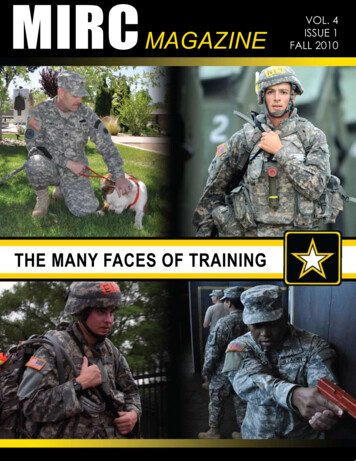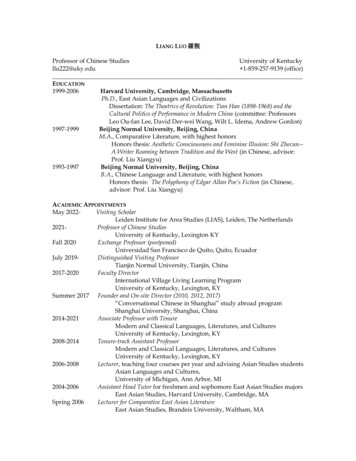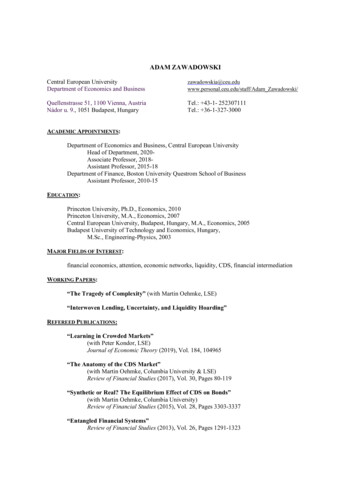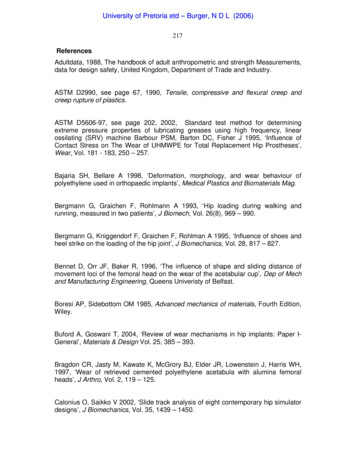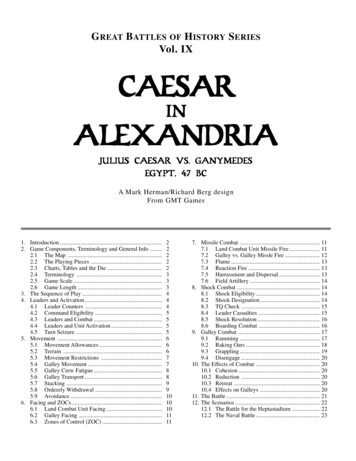
Transcription
Great Battles of History, Volume IXG REAT B ATTLES OF H ISTORY S ERIESVol. IXCaesarinAlexandriaJulius Caesar vs. GanymedesEgypt, 47 BCA Mark Herman/Richard Berg designFrom GMT Games1. Introduction .2. Game Components, Terminology and General Info .2.1 The Map .2.2 The Playing Pieces .2.3 Charts, Tables and the Die .2.4 Terminology .2.5 Game Scale .2.6 Game Length .3. The Sequence of Play .4. Leaders and Activation .4.1 Leader Counters .4.2 Command Eligibility .4.3 Leaders and Combat .4.4 Leaders and Unit Activation .4.5 Turn Seizure .5. Movement .5.1 Movement Allowances .5.2 Terrain .5.3 Movement Restrictions .5.4 Galley Movement .5.5 Galley Crew Fatigue .5.6 Galley Transport .5.7 Stacking .5.8 Orderely Withdrawal .5.9 Avoidance .6. Facing and ZOCs .6.1 Land Combat Unit Facing .6.2 Galley Facing .6.3 Zones of Control (ZOC) .22222333444555566677889910101011117. Missile Combat . 117.1 Land Combat Unit Missile Fire . 117.2 Galley vs. Galley Missle Fire . 127.3 Flame . 137.4 Reaction Fire . 137.5 Harrassment and Dispersal . 137.6 Field Artillery . 148. Shock Combat . 148.1 Shock Eligibility . 148.2 Shock Designation . 148.3 TQ Check . 158.4 Leader Casualties . 158.5 Shock Resolution . 168.6 Boarding Combat . 169. Galley Combat . 179.1 Ramming . 179.2 Raking Oars . 189.3 Grappling . 199.4 Disengage . 2010. The Effects of Combat . 2010.1 Cohesion . 2010.2 Reduction . 2010.3 Retreat . 2010.4 Effects on Galleys . 2011. The Battle . 2112. The Scenarios . 2212.1 The Battle for the Heptastadium . 2212.2 The Naval Battle . 231
Caesar in Alexandria1. INTRODUCTIONused (A arrow or J javelin). The Land Unit Missile Tablegives the Ranges over which these missiles may fire.Caesar in Alexandria simulates the efforts of Arsinoë, sister ofCleopatra, to retake Alexandria from the Romans and Julius Caesar. The two main features of this extended battle/siege were streetfighting and a naval engagement.Design/Play Note: There is no Size Rating as in most other GBoHgames. For informational purposes, each infantry unit containsabout 200 men, archers about half. Thus, Caesar’s defending forcenumbers around 5,200 legionnaires; Ganymedes’ army numbersaround 9,000, not including archers.Important Note to GBoH Gamers: Many of the rules andmechanics which are part and parcel of all previous GBoH series,land and sea, have either been changed or are not around anymore.Much of this has to do with the differences between street-fightingand the linear warfare of the era. Do not assume that any previousGBoH rules apply to Alexandria.2. GAME COMPONENTS,TERMINOLOGY ANDGENERAL INFORMATIONThe game includes:1 22x33” game-map1 Sheet of 280 counters1 Rule Book1 Charts and Tables Folio2 Galley Holding Box Cards1 10 sided die2 6 sided dice2.1 THE MAPThe map of Caesar in Alexandria contains both hexes and, torepresent the city, point-to-point movement along streets, whichsurround “Blocks”. As such, its terrain is far different from otherGBoH games. That terrain is discussed below.Hexes use their printed number for identification. In Alexandriaproper, Roads, which run generally east-west, are numbered;Streets, which run generally north-south, are lettered. A “Block”(or built-up area) is identified by the four surrounding roads/streets.Example: 2/3-K/L is the Block that contains the Palace.The eastern end of Alexandria, as well as the clear and marshyland south of the city, has been excluded, as they did not see, norwould they in a game, any action.2.2 THE PLAYING PIECESThere are four types of playing pieces, or counters: Land CombatUnits, representing the various types of fighting troops; Galleys,the ships of the respective Fleets; Leaders, the individuals whocommand the troops; and Information Markers used to note certain types of information necessary for play.(2.21) Each land combat unit is a specific type—and (possibly)class (as illustrated below)—depending on its weaponry, bodyarmor/protection and level of experience. All land combat unitsare rated numerically for Troop Quality (TQ) and Movement capability. Units (other than artillery) that are capable of firing missiles also have a Missile Indicator, indicating the type of missile2Major change from previous GBoH games: the reverse side ofthe counters does not show “Moved” status. In Caesar in Alexandria, the reverse side shows that the unit is Reduced (10.2).(2.22) Each unit is of a certain Type, such as CO (cohorts), MI(Medium Infantry), etc. Cohorts (CO) are further subdivided intoClass: either VET (Veterans) or REC (Recruits). These descriptions are used to determine the effectiveness of one type/classwhen fighting another.(2.23) Examples of Land Combat UnitsLegion Cohort (Veteran)FrontUnit I.D. (6th Legion, 1st Cohort)Class (Vet)Unit Type (Legion Cohort)Movement AllowanceBackTroop Quality (TQ)Medium Infantry (Egyptian)FrontBack(Reduced Side)Unit I.D. (Egypt #1)Unit Type (Medium Infantry)Movement AllowanceTroop Quality (TQ)ArchersFrontUnit I.D.Missile Type (Archer)Unit Type (SK)Movement AllowanceBackTroop Quality (TQ)(2.24) Galleys. Unlike the ships of our War Galley game, thegalleys are the same size counter as the land units. Galleys arecombat units. Galleys are rated numerically for Crew Quality,Ramming ability, transport capacity, and Movement.Each ship counter represents 3 ships. Because of the scale, we arenot using the double-sized counters for galleys, as we did in WarGalley. For those interested in background and detail, that gamecontains a lot of peripheral/historical information about ships, etc.
Great Battles of History, Volume IXFront (Cruise Speed)Ram Attack/DefenseTransport CapacityMovement AllowanceCrewUnit I.D.Back (Attack Speed)mation. In the game this is measured in the form of Cohesion“hits”.Crew Rating: A measure of a galley crew’s ability to performnaval activities. This is the single most important galley rating.DR/DRM: Die roll, and Die roll Modifier.Fatigue: The adverse affect on a galley of repeated naval combator high speed maneuvering.MA: Acronym for a unit’s basic Movement Allowance. It alsorepresents a unit’s maneuverability vis a vis other units in thegame.(2.25) Leaders have a somewhat different, and less detailed, setof ratings than in previous GBoH games. These are discussed insection 4.2. This is a major change from previous GBoH games.(2.26) Informational Markers, such as “#’s” (representing Hitstaken), “Rammed”, “Captured”, etc., are used to record certaingame functions, as discussed below.(2.27) maticusBiremeTriremeQuadriremeQuinqueremeLiburnian BiremeCataphracted TriremeTransport2.3 CHARTS, TABLES AND THE DIEThe use of each chart and table is explained in the rules. Many ofthe detailed Charts and Tables from previous GBoH games arenot used.The game uses a 10-sided die for all land-oriented die rolls; the‘0’ is treated as a ‘0’ (not a ‘10’), and is less than ‘1’.One or Two six-sided dice are used for naval combat and othernaval activity. Each table notes which dice are used. If two diceare used (abbreviated 2d12 in the rules), the values of the individual die’s are totaled to produce a sum between 2 and 12.2.4 TERMINOLOGYKnowledge of the following game terms will be useful for play.Activated Leader: The leader who has been selected to undertake the Player Turn. Only one leader may be active at any onetime.Block: the sections of the map, inside Alexandria, that representclosely-built urban areas, with narrow streets. Very confining.Boarding: hand-to-hand combat between troops on mutuallygrappled galleys. The core of Roman naval tactics.Class: Sub-category within the Cohort type, used to differentiatebetween levels of training and experience. Cohorts are either Veterans or Recruits.Missile Volley: Friendly units throwing javelins, shooting arrows,or firing artillery at enemy units.MP: Movement Points.Player Turn: When a player gets to move/fight with all the unitsof one, individual command (see 4.1).Rake: A galley attack with the object crippling an opponent byshearing off its oars.Ram: A galley attack with the object of disabling an opponent bydamaging its hull.Reduction: The loss of manpower that reduces a unit’s overalleffectiveness.Shock Combat: Hand-to-hand, (and, often literally, eyeball-toeyeball), hack and thrust, slash and crash, melee. Heavy work;not for the skittish.TQ: Acronym for the all-important Troop Quality rating. It willbe consulted constantly throughout play—at almost any time aunit does something that will endanger its cohesion.Transport Capacity: The number of land combat units that agalley unit may carry.Turn Seizure: The mechanic whereby one player stops the otherfrom going, and, thereby goes himself.Type: General, categorical description of combat unit, usuallyused to determine combat effectiveness and results. Examples:CO (Cohorts), LI (Light Infantry), etc.Zone of Control: The hexes—usually directly to the front of aunit—into which a unit exerts, by its presence, enough “influence’ so as to inhibit freedom of movement.2.5 GAME SCALEEach hex is approximately 125 yards from side to side. The distance between points varies, but it’s around that number. The various events of Alexandria took place over several days, maybeweeks. We have compressed them into one, continuous event.2.6 GAME LENGTHThose familiar with the rules, and the tactical problems the gamepresents, should finish this in one long sitting. The smaller scenarios can be finished in about 3 hours.Cohesion: A unit’s ability to remain in an organized, fighting for-3
Caesar in Alexandria2.7 QUESTIONSSend an SASE to:GMT GamesAttn: Caesar in AlexandriaPOB 1308Hanford CA 93232-1308The quickest way to reach us for Q&A is via e-mail and theInternet: E-mail to bergbrog@aol.com, AlanJRay@msn.com, orgmtgames@aol.comTo get the most up-to-date game errata and information regardingthis and other GMT Games, check out our web site atwww.gmtgames.com And we’re on the Consimworld discussionboards several times a week. You can check out that site atwww.consimworld.com.3. The player must check to see if any of his Rammed Galleyssink (see 9.42).E. Exhaustion Level Check: See 11.0. Exhaustion is not used inthe two short scenarios.F. Victory Determination: See 11.0 and 12.0.4. LEADERS ANDACTIVATION4.1 LEADER COUNTERSOverall CommanderJ. CAESAR3. THE SEQUENCE OF PLAYPLAThe game consists of an indeterminate number of Player Turns,as below. The players alternate turns, subject to a successful TurnSeizure (5.0), until one player achieves his victory conditions oruntil both armies reach their Exhaustion Level. The player currently conducting the Player Turn is the active player. When he isfinished, the Player Turn passes to the opposing player.The Player TurnA. Activation Phase. The active player may do one of the following: Activate one of his Subordinate Leaders and any eligible combat units (see 4.12) that are within his Command Range; OR Activate his Fleet. This activates all the player’s Galleys andany/all units transported by them; OR Activate all his Auxiliaries (see 4.12); OR Move his Overall Commander. No other units are activated.Steps C-F are skipped if the player chooses to move his OverallCommander.B. Movement and/or Missile Fire Phase: Activated units mayMove and/or conduct Missile Fire. Galleys may Ram, Rake,Grapple, etc.C. Shock Combat Phase: Activated land combat units conductShock or Boarding Combat.D. Fleet Status Phase (Fleet activation only): The active playerperforms the following actions, in the order listed, for all of hisaffected Galleys at the end of a Fleet activation.1. The player may attempt to Disengage any of his Galleys thatare Fouled (see 9.44).2. The player must make a Firefighting Check for each of his Galleys that are On Fire (see 7.32). If any of his Galleys remain OnFire, the player must check to see if the Fire spreads to any galleyGrappled/ Fouled to it (7.33).4NameSeizure RatingMovement AllowanceRankInitiativeCharisma (Heroic)Overall Commanders have the following Ratings:Seizure: The number of times that leader may attempt Seizureduring the game. Use a Strength marker to indicate the number ofattempts used.Initiative: This rating is used to determine the success of an attempt to Seize the Initiative from the opposing player, cancel hisactivation and substitute yours.Charisma: Denotes his ability to spur his troops on to greaterefforts. The rating is used to adjust the die roll on the Shock Combat Results Table in his favor for combat units with which he isstacked. Heroic Charisma is the same as Charisma, with the addition that it applies to all units in an adjacent land hex or point ofthe leader. The additional effects of Heroic Charisma do not apply if the leader is in a Block or on a Galley.Movement Allowance: The number of Movement Points available for the turn.Subordinate LeaderReplacement and Range: Denotes his overall presence as well as theeffectiveness of his abilities: the distance over which that leadermay exert his abilities. Unlike other GBoH games, the range ismeasured in Movement Points (see 5.11).
Great Battles of History, Volume IX4.2 COMMAND ELIGIBILTY(4.21) Roman Subordinate Leaders (Legates) may activate cohorts of their own legion, Artillery, or any Gallic MI (actually,dismounted cavalry). They may not activate Archers, Light Infantry, or cohorts from another legion. Archers, Light Infantry,Artillery, and the Gallic MI may be activated as Auxiliaries.Play Note: It costs one additional Movement Point to traceCommand Range into a friendly occupied hex/Point.Design Note: We are tracing command differently to account forthe various types of terrain and the very restrictive nature of cityfighting.(4.22) Egyptian Subordinate Leaders may activate any landcombat unit. Archers and Artillery may also be activated asAuxiliaries.(4.23) The Overall Commanders, Caesar and Ganymedes, maynot activate combat units.(4.24) Command Eligibility Chart. See Charts and tables.4.3 LEADERS AND COMBATThis section covers general rules relating to leaders and enemycombat units. For specific rules for leader casualties from MissileFire and during Shock, see 7.18 and 8.4.(4.31) Leaders may not move adjacent to an enemy unit in a hexor point, or into an enemy occupied Block unless stacked with, ormoving onto, a friendly combat unit.(4.32) Leaders stacked with combat units threatened by Shockmay, if the player wishes, Retreat one hex/point but never intoa Block. The instant any enemy combat unit moves adjacent to aleader alone in a hex/point/Block that leader may immediatelyretreat up to two hexes/points (no Blocks). The leader may notretreat through enemy units or impassable terrain. If the leadercan’t retreat, he is killed. Leaders aboard Galleys don’t retreat.(4.33) All leaders, other than Caesar and Ganymedes, may beReplaced when killed. At the end of the Activation in question,place the leader, replacement side up, on any friendly unit that theleader is eligible to command.Play Note: “All leaders” includes those already on theirReplacement side.(4.34) If Caesar is killed, the Egyptians automatically win.4.4 LEADERS AND UNIT ACTIVATIONCombat units may not move or missile fire unless they areactivated.(4.41) When a Subordinate Leader is activated, eligible units (see4.2) within his Command Range may be activated. The range ismeasured in Movement Points, whether they are Points or Hexes.Moreover, while a Command Range may be traced into a Block(and only from an adjacent Point); it may not be traced through aBlock. A path is obstructed by hexes/Points occupied by enemyunits, an unoccupied hex in an enemy Zone of Control (ZOC),or terrain a leader could not cross or enter. Friendly units negate enemy ZOCs for purposes of tracing Command Range.All other paths are considered unobstructed. Command Rangemay be traced from/to leaders/units aboard galleys that areBeached, Aground, in Slips, or grappled to the HeptastadiumCauseway. It costs 3 MP to trace Command into/from a Galleythat meets these conditions.Example: Sosius is in Point 4-K. He could activate any Egyptianunit in any/all of the three adjacent Blocks plus all units in Pointswithin 6 MP of his position. Note that it costs an additional MP totrace Command into an occupied Point. So if the Points on road 4were occupied from Streets H through N (inclusive), only thoseunits from Streets I through M could be activated.(4.42) When a player activates his Fleet or Auxiliaries, all units ofthat type, regardless of location are activated. A Fleet activationalso activates all land units that are on board the Galleys. Theseland units may missile fire, conduct Boarding combat, disembarkand conduct Shock combat, etc.(4.43) If the player decides to move his Overall Commander (per3.0 Phase A, 4th bullet), no other units are activated. However, anOverall Commander may move (debark, use his Charisma) during a Fleet activation if he started the Player Turn aboard a Galley, or if stacked with an activated land combat that moves. In thisinstance, the OC must remain stacked with the combat unit.(4.44) There is no prohibition as to which Leader (or Auxiliaries/Fleet) may be selected in a given Player Turn. Leaders aboardgalleys that are Beached, Aground, in Slips, or grappled to theHeptastadium Causeway may activate themselves and any eligible units that meet the conditions in 4.41. Note that this is not aFleet activation.Play Note: This means that if the Roman player activates XLegion, followed by the Egyptian player activating his galleys,when the turn flips back to the Roman player, he may, again,activate X Legion.4.5 TURN SEIZURE(4.51) When it is a Player’s Turn, and before that player designates which units he will activate, his opponent may attempt toSeize the Turn. To do so the seizing player rolls the die: If the DR is the same as or lower than the Overall Commander’sInitiative Rating the first player’s Turn is canceled and it is nowthe turn of the Seizing Player If the DR is higher than the Overall Commander’s InitiativeRating, the attempt fails.5
Caesar in AlexandriaPlay Note: And the penalty for failure is that the seizing playerwasted one of his opportunities.(4.52) A Player may attempt Turn Seizure as many times duringthe game as his Seizure Rating allows. Use a Strength markerunder the leader to keep track of the number of Seizure attempts.A player may not make a Seizure attempt twice in succession, normay he make an attempt on the first Player Turn of the game.(5.23) When moving Inside the city (including the town on Pharos),units move from Point to Point along the streets/roads, changingdirections as they wish. A unit may move into a Block from anyadjacent Point. It costs a unit its entire printed Movement Allowance—and, thereby, a full Activation—to move into a Block. Aunit in a Block may move into any adjacent Point by expendingthe appropriate MP cost (see 5.36).Example: The Egyptian Player, as Ganymedes, can attemptSeizure five times, success coming on a DR of 0-3 for each attempt.(4.53) The opposing player may not attempt to Seize back theturn after a successful Seizure attempt.Example: The Roman player has just completed his turn. It isnow the Egyptian player’s turn. The Roman player decides tomake a seizure attempt with Caesar and succeeds. The Romanplayer now has a player turn instead. After the Romans take theirturn, play now passes to the Egyptians. The Roman player cannotagain make a seizure attempt per 4.52, so the Egyptian playerwill be able to complete his turn.5. MOVEMENT5.1 MOVEMENT ALLOWANCES(5.11) A unit’s printed Movement Allowance is the basic allowance for a single Player-Turn. An activated combat unit may moveup to its printed MA. Units may always move less than the printedMA (but see 5.43).Play Note: There are no Cohesion Hits for any movement (as inprevious GBoH games), as sieges rarely require use of formations.(5.12) Activated Subordinate leaders may move when activated,but only after all combat units have moved.5.2 TERRAINThe Alexandria map contains two different types of base terrain:Inside and Outside of the City. The area Outside of the city has ahex grid overlay as used in other games in the series. The Insidepart of the City is divided into Blocks separated by the streets/roads of the city which connect a series of Points. Units Inside theCity are positioned in either the Blocks or Points—they are analogous to the hexes Outside of the City.(5.21) When moving Outside the city, units move from hex toadjacent hex paying the appropriate Movement Point cost to enter the hex, or cross a hex side.(5.22) A unit may move from Outside the City to/from Inside theCity by moving from a hex to an adjacent Point. Hexes adjacentto a Point are marked with a small arrow. A unit may move to/from a hex to a Point only if they are connected by an arrow. Aunit in a hex may not move directly into a Block nor may a unitmove from a Block to hex; it must first move into a Point. Furthermore, a unit may not move from a Block to another Blockwithout first entering a Point.Example: Point 4-D is adjacent to hexes 2023 and 2024.62KL3Example: 2/3-K/L is the Block that contains the Palace. A unitmay enter the Palace Block from the three Points between 2/3-Kinclusive and the three points between 2/3-L inclusive.(5.24) Canal: Units moving from Point to Point ignore the canal.Units moving from a Point into a Block (and vica versa) may notcross the Canal. Units may cross a canal to/from a Point to a hexor from a hex to another hex at the cost of one additional MP. Thecanal separates Block 2/3 - N/O into two separate blocks.Unitsmay not enter Block 2-M (bordering hex area) through a canalhex side nor may they move from one Block to the other acrossthe Canal.Example: A unit in Point 3-O cannot move into Block 3/4-N/O.(5.25) Heptastadium Causeway: Though portrayed as hexeson the map, Causeway terrain is treated as if it were a Point forall purposes unless otherwise stated in the rules. These “hexes”are treated as land; they may not be entered by Galleys with oneexception: Galleys may move through the two “Overpasses” ateach end, as if they were sea hexes. Galleys may not end movement in these hexes, nor may these hexes be entered if occupiedby an enemy land unit, or if both egress hexes are occupied byother galleys.(5.26) The Lighthouse: This feature is treated as a hex for movement and combat. The player who has any combat unit in theLighthouse may deny entry of any galley into 3931-2 and/or 4032.Furthermore, units in the Lighthouse benefit from favorable combat modifiers and have special stacking restrictions.(5.27) Slips: Galleys that move into a Slip hex—representing thedocks and sheds that housed the fleets—must cease movementfor that player turn, though they may then be turned around toface in whatever direction the player wishes. A galley may notmove from one Slip hex directly into another Slip hex. Galleys inSlips may not be Rammed or Raked; they may be Grappled (andBoarded) and fired at. In addition Slips may be set afire by Missiles, if no galleys are in the Slip. If there are galleys present, theymust be the target.(5.28) Shoals: Galleys pay a higher Movement cost to enter aShoal hex. In addition, for each Shoals hex entered, the playerrolls a 1d6. If the DR is 6 or higher, the galley has run aground
Great Battles of History, Volume IXand is stuck for the rest of the game. Galleys at Attack SpeedLevel add ( 1) to this die roll.(5.29) Beach: Galleys that end their turn in an eligible coastalhex may Beach in order to debark land units. Galleys may beachon Pharos only on the northern side of the island (from 3204through 4130, inclusive), or on the coastal hexes west of the city(from 1005 through 1814 inclusive). See 5.48.5.3 MOVEMENT RESTRICTIONS(5.31) A unit expends Movement Points for each Hex, Point, orBlock it enters, as per 5.36. As a unit moves it traces a path ofcontiguous Hexes/Points through the hex grid, paying the cost ofeach Hex/Point entered. One unit’s movement must be completedbefore another can begin, even if they start stacked together.(5.32) A unit may be moved in any direction or combination ofdirections. However, a combat unit may only enter a Hex or aPoint which is to its Front (6.11, 6.15, and 6.2). In order for a unitto change direction to its Flank/Rear it must first change facing(6.12 and 6.2) by pivoting in the Hex/Point it occupies. Exception: Galleys may Backwater (see 5.47).Important Play Note: The above applies to Hexes and Points,not Blocks. A unit may enter a Block from an adjacent Pointregardless of facing.(5.33) Units may not cross Walls, except at the Main Gate. Landunits may not cross an all-sea hex side unless transported by aGalley, while Galleys may not move across an all land hex side.All unit types may enter Coastal hexes.Play Note: The thin stretch of land at the eastern end of Pharos(hexes 4020-4027) is an example of a land hex side that a Galleycould not cross.(5.34) A moving unit must have enough MP’s to pay the terraincost of entering a Hex/Point/Block; if it doesn’t, it cannot enterthat Hex/Point/Block. Units also may have to pay movement pointcosts to change facing; see 6.1 and 6.2.(5.35) Galleys may move into and through sea hexes that alsocontain a city wall with no penalty. However, the player may notdebark units in those hexes (see 5.63). Galleys may not movethrough the mole guarding the King’s Harbor.2 MPs2 MPs1 MPSHOAL6 Run Aground (1d6)1 MP(5.36) Terrain Effects and Movement Cost Chart: This chartgives the Movement costs for each type of unit moving (or changing facing in) into/across a specific type of terrain.5.4 GALLEY MOVEMENTThe Movement Ratings for the galleys in this game are used ratherdifferently than in War Galley. There is no Wind used in this game.(5.41) Each Galley is always at one of two Speed Levels: Cruise(the front of the counter) or Attack (the reverse). The Speed Leveldetermines which types of actions (Ram, Beach, etc.) a Galleymay use during the activation. The Movement Allowance represents the maximum number of Movement Points (5.31) that galley may expend during its turn.(5.42) The Speed Level for each ship—which side of the counterto use that turn—is determined at the start of each Activation.Speed Levels are determined for each galley individually, prior toany movement. Galleys that are immobile, Crippled, have a Fatigue Level of 4 or more, or have had their Movement Allowances reduced to half through Collision or Capture must be placedat Cruise Speed. For all other galleys, the player may choose either Attack Speed or Cruise Speed.(5.43) The actual number of Movement Points that a Galley willuse that turn is chosen—and announced—prior to actually moving the ship, and the Galley must then use all of those announcedMP, unless it either Rams, or collides with, another ship, or runsaground. Galleys at Attack Speed must declare at least two Movement Points of movement.Example: A Liburnian Bireme is at Cruise speed, which meansthe player may expend from 0 to 8 MP when moving the ship. Theplayer decides to row at a speed of 5 MP, which he announcesprior to moving the unit. The Bireme must now expend all 5 MP unless s
Caesar in Alexandria simulates the efforts of Arsinoë, sister of Cleopatra, to retake Alexandria from the Romans and Julius Cae-sar. The two main features of this extended battle/siege were street- . Legion Cohort (Veteran) Medium Infantry (Egyptian) Archers (2.24) Galleys. Unlike the ships of our War Galley game, the






